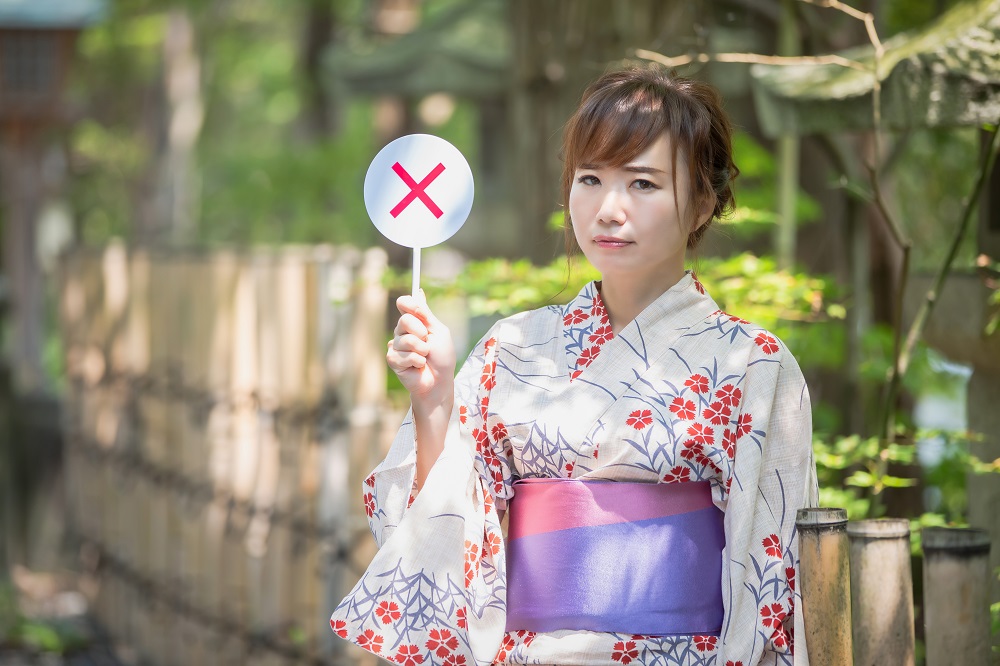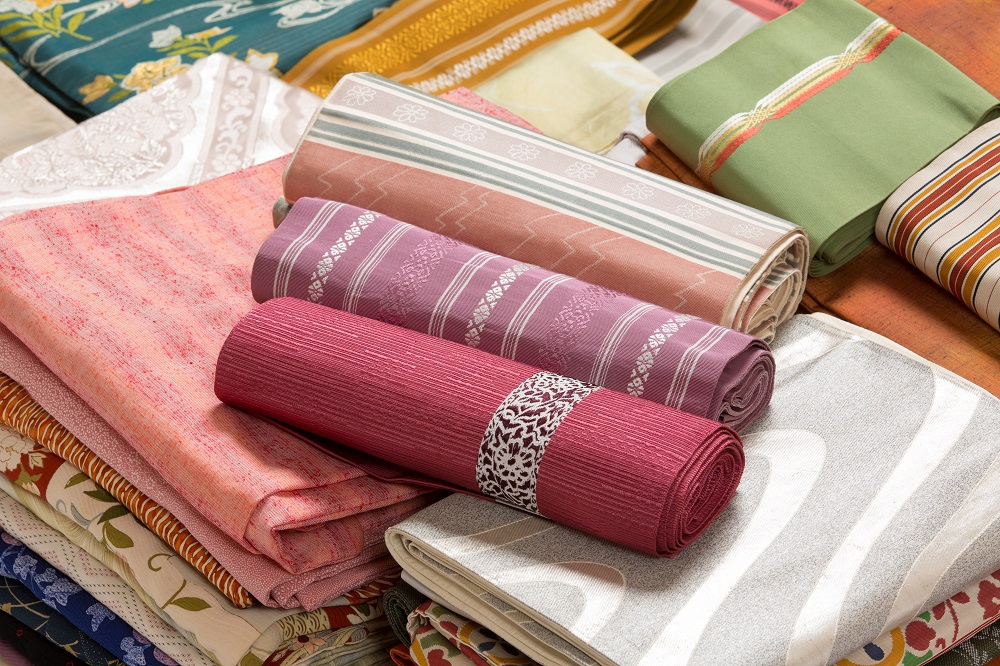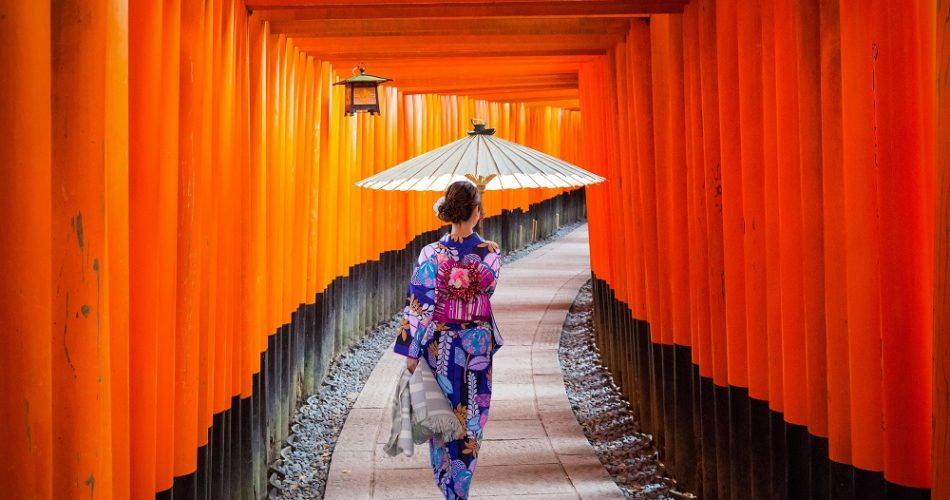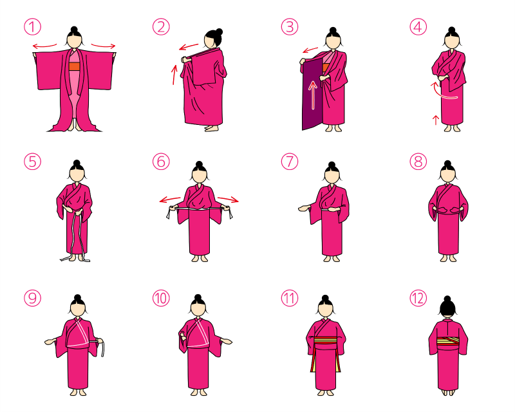Kimono is Japanese traditional dress that have spread its elegance and gorgeous charm around the world. It can be worn by both men and women with decorative belt called Obi and other colorful accessories.
The beauty of Japanese women dressed in splendid Kimono has been praised not only by fashion designers but also by photographers through art exhibitions. More and more foreign tourists become interested in Kimono culture and are likely to wear it while walking in ancient towns of Japan such as Kyoto and Asakusa.
The Kimono rentals have surged in recent years in Kyoto to revive the tourism industry and meet the tourists’ demand of experiencing Kimono dressing. Tourists can now easily rent a Kimono with around 3000 yen including hair set and make-up price.
Break the rules

However, the rapid growth of Kimono rental services has caused many troubles not only to foreign tourists but also to local people. Many tourists wear Kimono without awareness of its dressing basic rules and proper ways of walking. They wear Kimono with right side over left, which is how you dress dead person at his/her funeral.
I wonder if they got help from Japanese staffs to wear Kimono. Some even do not wear obi belt which is an indispensable element of Kimono. I saw many ladies in Kimono made up of curtain-like materials and cheap fabric fibres and they were wearing tabi “socks” with split toe which look like the ones that children usually wear in Shichigosan festival.
Some wear Haori-a hip/thigh length jacket worn over a kimono in winter improperly. One thing should be clarified is that those clothes are not real traditional Kimono. There are concerns about the present Kimono rental services which employ Kimono as a means of making money without realization of its true essence.
I saw people in Kimono or Yukata walking uphill to Kiyomizudera in haste. They seek to lengthen their stride in front to walk faster but kimono is fairly tight, additionally the wooden sandals are difficult to walk, so they ended up in clumsy awkward gait and sometimes they twist their legs and fall down on the streets. I even came cross men who wear Haori Hakama which is a formal kimono jacket worn in solemn ceremonies like the coming-of-age ceremony. Is it really true that Kimono rentals will rent any kinds of Kimono out to customers regardless of their purpose.
Basic dressing rules
Tourists are welcomed to put on Kimono and spread Japanese culture over the world. However, before wearing Kimono, let’s learn some basic rules first to show respects to Kimono and Kimono enthusiast:
- Left over right: Be sure that the right side is put under the left one if you do not want to imply to people that you are dead.

Figure 1. How to wear Yukata-summer Kimono. Source: jw-webmagazine.com - Use special bra or slip for Kimono: Because Kimono has round and firm collar that shows your neck and part of your back, wear a special bra/slip with deep collar so that it cannot be seen from outside.

Figure 2. Kimono collar. Source: wasouing.com
Figure 3. Kimono slip. Source Rakuten.com - Choose the right size: In order to look perfect in Kimono, it is necessary to choose the right size so that it gives you a tube-shaped body and you can walk for a long time without worry that it will slip off your body.
- Wearing Kimono with dignity: Japanese ladies wear Kimono with modesty and dignity to show the women’s elegant beauty. Next time when you wear a Kimono, please pay attention to your behaviors and small step strides and never run while wearing Kimono. Most importantly, wear the right type of Kimono in correspondence with the occasion.
- Cover your ankles: The bottom of Kimono should be kept parallel to the ground and cover your both ankles.
Kimono materials

Various materials can be used to make Kimono including silk, cotton, hemp (for high quality Kimono) and polyester (for low quality one). Silk, which is a natural fiber produced by silkworm cocoons, is considered to be the finest and the most perfect material for Kimono because of its beautiful luster, smooth and lightness. It is characterized by fairly good absorption of dying chemicals, thus patterns on silk Kimono can be dyed glossily for a vivid look. In addition, Silk is a material with excellent water absorption, hygroscopicity, breathability, and heat retention. In hot weather, it can absorb sweat even if you sweat, and it can release moisture quickly. On the other hand, silk is made of long fibers which retain a lot of air between the fibers, so it is a material with high heat retention that keeps you warm in winter although the layers are thin. Major drawback of silk is that it is sensitive to water and has the property of shrinking when getting wet. Therefore, be careful not to get it wet while walking under the rain. Also, never wash it with water even if it gets dirty. Being a natural material, it is easily eaten by insects, so silk Kimono requires serious care.
Cotton is a natural fiber from cotton seeds. Compared to silk, which is composed of protein, cotton is mainly composed of cellulose, which is a plant fiber. Since cotton is made of thick fibers, cotton thread is thicker than silk thread. Kimono woven with such cotton thread is thicker than silk kimono, and it has a simple plain texture. Therefore, cotton Kimonos can be worn casually for outings and everyday wear.
Cotton has excellent hygroscopicity and breathability and gives a soft touch like a peach’s skin. It is a material often used for unlined kimonos which is suitable for spring and summer because it has no lining and good breathability which let more air go through. Summer Yukata is also made of cotton which gives you a cool feeling in the incredibly hot and humid summer of Japan. Also, since cotton does not have a glossy or moist luster, it is not suitable for formal occasions. One of the advantages of cotton is its resistance to water, so you can easily wash it at home.
Hemp is a natural fiber made from hemp, ramie, and flax. Fibers made from hemp are called hemp, fibers made from ramie are called ramie, and fibers made from flax are called linen. Hemp and ramie have long been used in Kimono in Japan and have been called hemp fabrics. Hemp Kimonos were common until the early Edo period when cotton fabrics became predominant. Hemp is a material that has high water absorption. Therefore, it is suitable for summer wear because it absorbs sweat well and dries quickly even in the hot season. In addition, the linen kimono is textured and fine wrinkles called grain are added to the entire surface of Kimono. Due to the rough surface, the area that comes into contact with the skin reduces and the texture is so smooth that it often gives you crisp touch and does not stick to your skin even if you sweat. From various points, it is said to be the best material for summer.
Polyester is a chemical fiber made mainly from petroleum. It is a fiber produced from PET resin used for PET bottles and can be manufactured at low cost. One of the characteristics of polyester fiber is that it dries easily and is durable. It has fairly low water absorption and hygroscopicity. While it is difficult to absorb sweat, it is strong against washing and can be dried immediately. In addition, it is less likely to get creased and has good crease recovery property. Unlike natural fibers such as silk and cotton, it is not discolored by ultraviolet rays when exposed to sunlight after a long time. The surface is glossy and smooth with good dyeing and weaving properties that can express vivid flashy patterns. Polyester dries easily, but it does not easily absorb sweat, making it unsuitable for summer and hot and humid seasons. In addition, friction can easily generate static electricity and cling to your legs while walking.
At the end, I will introduce a video of how to wear a kimono.





Comments